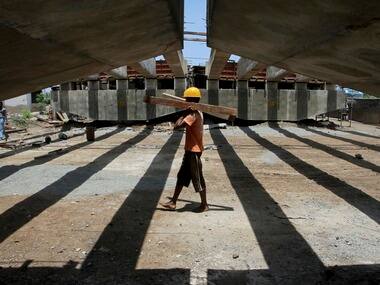Forget 7 percent growth, India will be extremely lucky if it manages 6-6.5 percent growth this year.
Over the past few days, three top international investment houses have downgraded India’s gross domestic product (GDP) estimates. On Friday,Goldman Sachs was the latest to cut India’s GDP estimate to 6.6 percent from 7.2 percent for the financial year ending March 2013, citing a weak investment outlook because of policy uncertainties.
Also joining the downgrade brigade was Bank of America Merill Lynch, which cut India’s growth forecast to 6.5 percent from 6.8 percent earlier, although it said the eurozone crisis was more to blame for the change in estimate.
[caption id=“attachment_321104” align=“alignleft” width=“380” caption=“Another unkind cut came from Morgan Stanley earlier in the week: it axed India’s 2013 GDP forecast to 6.8 percent from 7.5 percent. Reuters”]
 [/caption]
[/caption]
Another unkind cut came from Morgan Stanley earlier in the week: it axed India’s 2013 GDP forecast to 6.8 percent from 7.5 percent (it also slashed 2012’s GDP estimate to 6.3 percent from 6.9 percent earlier). “With the continued lack of policy action to address the unsustainable growth mix, we believe that GDP growth is likely to face another leg down,“it said.
“Indeed, we believe that the growth slowdown will be both deeper and more prolonged than what the consensus is expecting with adverse implications for the banking sector. At this juncture, we believe that the risks to the growth outlook remain skewed to the downside.”
No kidding. Note that none of these brokerages believe India will grow by 7 percent any more. And why should they? At the moment, it’s hard not to see India as an economic disaster in the making.
Consider these facts:
One, growth is undoubtedly slowing down down - with no turnaround in sight.
Two, inflation looks likely to climb higher, boosted by rising fuel and food prices. Current economist estimates range from 6.5 percent to 8 percent plus.
Three, exports are slowing down, while imports, especially those of oil, continue to remain high. Result: the trade deficit is likely to remain high, along with the current account deficit, which is estimated to have hit a high 4 percent in 2011-2012.
Four, the fiscal deficit - the gap between government revenues and expenditure - shows no sign of being reined in the current financial year. The government estimates the deficit at 5.1 percent, but chances are that figure will finally come in higher, just like what happened in 2011-2012. Especially if it attempts flop shows like hiking petrol prices, but not diesel’s, which only increase the already hefty subsidy burden.
Five, foreign investments, direct and portfolio, are getting stalled. Controversial proposals to retrospectively tax overseas transactions involving Indian assets and tax deals ‘aimed at avoiding tax’ are forcing international companies to rethink India investments. Foreign inflows into bond markets are down toRs16,3oo crore in 2012, from Rs 42,100 crore last year, a Bloomberg report notes , whileinflows into equity markets have hit nearly Rs 44,000 crore. Foreign inflows have slowed after the flood of the first three months, although there are no signs of a stampede to the exits.
Six, policy paralysis/uncertainty in a range of sectors from coal and power to airlines to telecom has also forced businesses to call a halt to further investments in capacity expansion.
**Seven,**all of these are piling pressure on the rupee. Experts now estimate the currency’s value could range anywhere between 52 and 58 in the next six months. Pertinently, almost no one believes that the rupee will appreciate to below 50 against the greenback any time soon.
In the absence of any measures to revive the economy, it will remain mired in the quicksand of slow growth. For a long, long time. As Rupa Rege Nitsure, chief economist at Bank of Baroda, tells Reuters : “It is the time to press the panic button. The government has to do something right now to reverse investor sentiment, so that India can start attracting capital inflows.”
Amen to that.
)